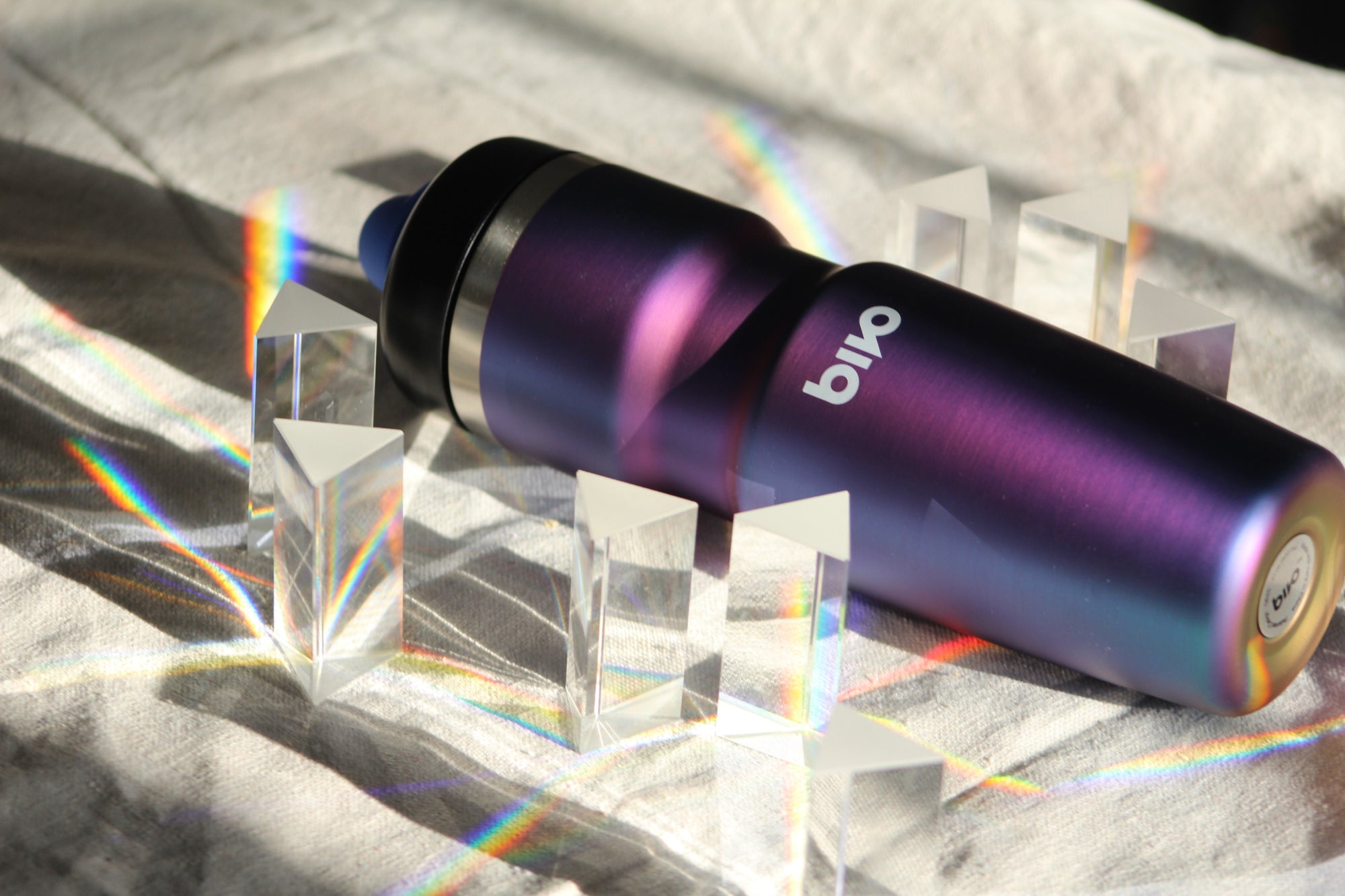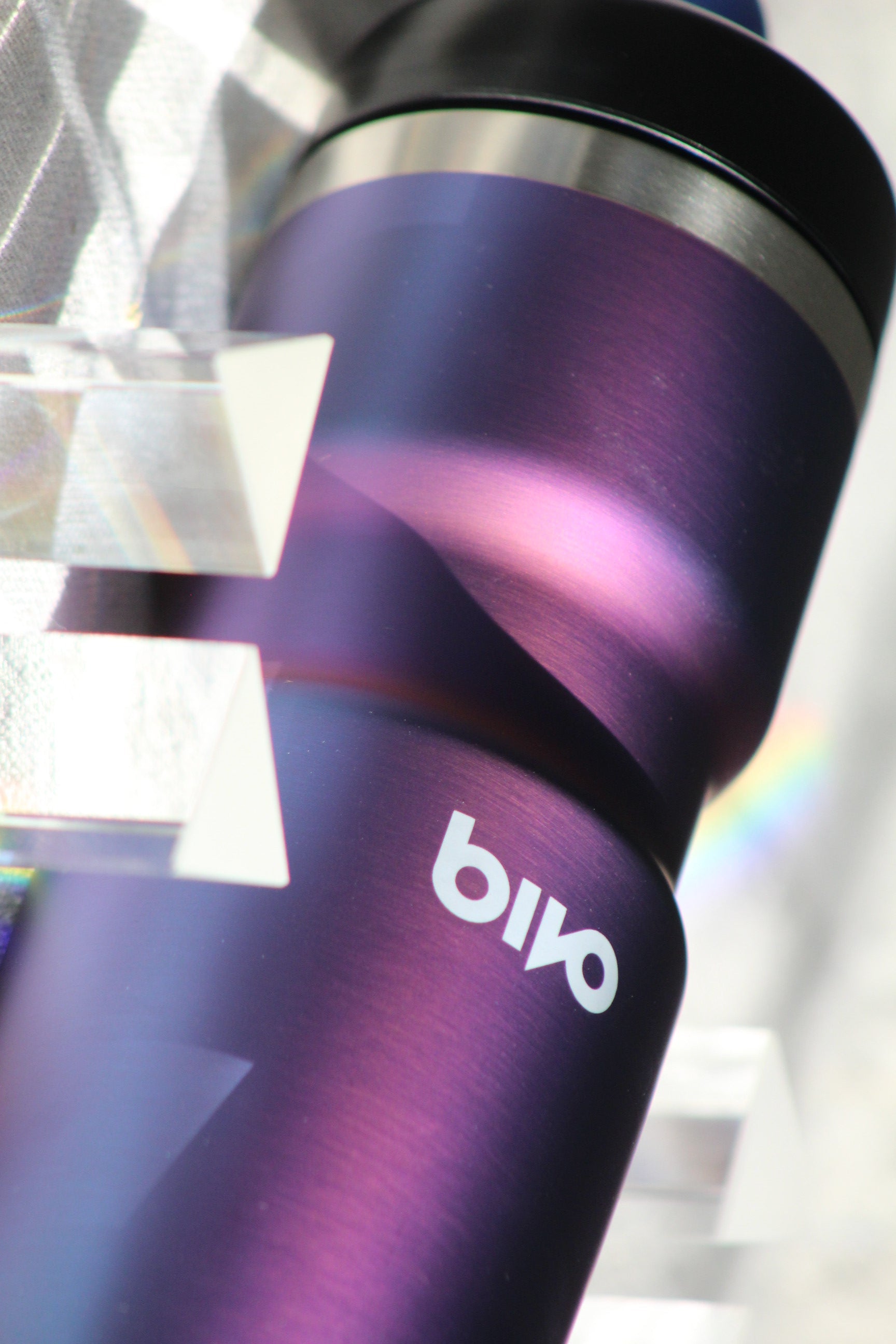Limited Edition Color:
November 13th, 2025 | by Keaton Smith
We couldn’t be more excited about the new, special edition bottle called Prism. Iridescent, colorful, and metallic, this bottle plays with light more than any other we’ve made. To celebrate its launch, we decided to learn more about the tool and object after which this bottle was named: the Prism!
So, I interviewed an expert: a physics teacher! Actually, my own High School physics teacher from Michigan: Mr. Arthur!I thought of him immediately when I knew we were launching a bottle called Prism, as I knew he would provide an entertaining and informative interview!
After a brief legal career, Mike Arthur taught math and science for the next 27 years. Currently retired, Mike is an avid sailor and amateur astronomy enthusiast. It was so nice of him to briefly step back into his teaching role to share his knowledge with me!
We couldn’t be more excited about the new, special edition bottle called Prism. Iridescent, colorful, and metallic, this bottle plays with light more than any other we’ve made. To celebrate its launch, we decided to learn more about the tool and object after which this bottle was named: the Prism!
So, I interviewed an expert: a physics teacher! Actually, my own High School physics teacher from Michigan: Mr. Arthur!I thought of him immediately when I knew we were launching a bottle called Prism, as I knew he would provide an entertaining and informative interview!
After a brief legal career, Mike Arthur taught math and science for the next 27 years. Currently retired, Mike is an avid sailor and amateur astronomy enthusiast. It was so nice of him to briefly step back into his teaching role to share his knowledge with me!
A prism is a triangular solid that bends light as it passes through. Light bends because it slows inside the prism. That is what we mean when we say it has a different ‘index of refraction’ compared to the air around it. An index of refraction is a measure of how much light slows down and bends when it passes through one material to another.
Lightwaves are bent in a prism, but since each color of light has a different wavelength, each wavelength of light ends up bending differently because each color has a very slightly different index of refraction. This causes the splay of rainbow colors that we see in a prism.
A prism is a triangular solid that bends light as it passes through. Light bends because it slows inside the prism. That is what we mean when we say it has a different ‘index of refraction’ compared to the air around it. An index of refraction is a measure of how much light slows down and bends when it passes through one material to another.
Lightwaves are bent in a prism, but since each color of light has a different wavelength, each wavelength of light ends up bending differently because each color has a very slightly different index of refraction. This causes the splay of rainbow colors that we see in a prism.
Thanks so much Joshua Strong for the above pictures!
Thanks so much Joshua Strong for the above pictures!
People have known that prisms disperse light for centuries. The first optical instruments were eyeglasses and Galileo's telescope in the early 1600’s, but people have made or worked with glass for longer than that and would have noticed the unique light interacts with glass early on.
Some of the first science was performed on prisms in the 1800s though, by Fraunhofer, who worked as an optician near Munich, and whose work laid the groundwork for spectroscopy, basically, the study of the absorption and emission of light and other radiation by matter and how different wavelengths impact it. This is how we know what the sun and stars are made of.
While the triangular prism was an object of science developed in the 1700s, we see the effect of prisms in nature in a few different ways.
One is in rainbows, which are caused because the water droplets in the air bend light as light passes through it, causing a rainbow of colors. Hence why we see rainbows when there’s a bit of light and rain!
Another is in diamonds, which are a very expensive sort of prism and, which has a very high index of refraction. Diamonds are cut so when light enters the diamond the high index of refraction causes it to reflect back up at the viewer. This can happen with an ordinary glass prism as well.
People have known that prisms disperse light for centuries. The first optical instruments were eyeglasses and Galileo's telescope in the early 1600’s, but people have made or worked with glass for longer than that and would have noticed the unique light interacts with glass early on.
Some of the first science was performed on prisms in the 1800s though, by Fraunhofer, who worked as an optician near Munich, and whose work laid the groundwork for spectroscopy, basically, the study of the absorption and emission of light and other radiation by matter and how different wavelengths impact it. This is how we know what the sun and stars are made of.
While the triangular prism was an object of science developed in the 1700s, we see the effect of prisms in nature in a few different ways.
One is in rainbows, which are caused because the water droplets in the air bend light as light passes through it, causing a rainbow of colors. Hence why we see rainbows when there’s a bit of light and rain!
Another is in diamonds, which are a very expensive sort of prism and, which has a very high index of refraction. Diamonds are cut so when light enters the diamond the high index of refraction causes it to reflect back up at the viewer. This can happen with an ordinary glass prism as well.
Mr. Arthur told me that when he started teaching, science classrooms had an abundance of large prisms to study, and there was one specific reason for that.
In WW2, prisms were an integral part of the periscopes on army tanks. Each tank had many spare prisms, in case their periscope was damaged. After many of these army tanks were decommissioned, all the excess prisms were put for sale, and science teachers around the country snatched them up to study!
Mr. Arthur told me that when he started teaching, science classrooms had an abundance of large prisms to study, and there was one specific reason for that.
In WW2, prisms were an integral part of the periscopes on army tanks. Each tank had many spare prisms, in case their periscope was damaged. After many of these army tanks were decommissioned, all the excess prisms were put for sale, and science teachers around the country snatched them up to study!
Big shoutout to Mr. Arthur for being the best, because when I reached out to him to chat, it turns out he had been retired 5 years, so it was just so kind of him to meet with me :)
While our new Prism bottle does not, of course, refract light in the way a glass prism does, we chose the name for its surprising and ever-shifting colors. Truly, the bottle looks different from every angle!
Plus, a fun matching periwinkle dirt cap comes with every bottle :)
Big shoutout to Mr. Arthur for being the best, because when I reached out to him to chat, it turns out he had been retired 5 years, so it was just so kind of him to meet with me :)
While our new Prism bottle does not, of course, refract light in the way a glass prism does, we chose the name for its surprising and ever-shifting colors. Truly, the bottle looks different from every angle!
Plus, a fun matching periwinkle dirt cap comes with every bottle :)






Leave a comment (all fields required)